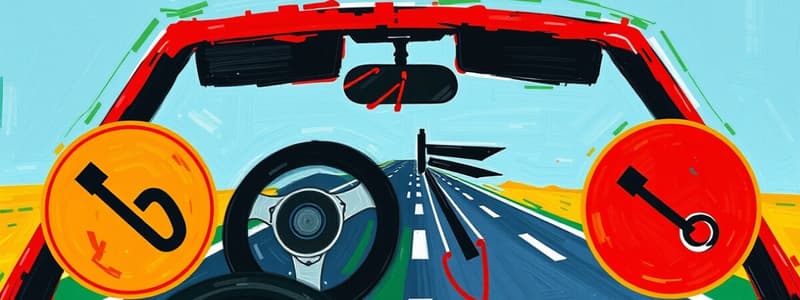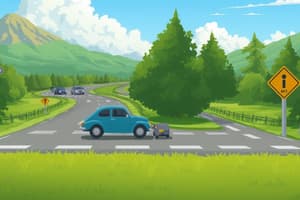Podcast
Questions and Answers
What should you do before passing a vehicle in your lane?
What should you do before passing a vehicle in your lane?
- Check your mirrors
- Speed up
- Honk your horn
- Be sure there is enough space (correct)
At what speed should you pass another vehicle going in the same direction on a two-lane roadway?
At what speed should you pass another vehicle going in the same direction on a two-lane roadway?
At least 10 mph faster than the other vehicle.
When should you slow for the advisory speed posted for a curve?
When should you slow for the advisory speed posted for a curve?
Generally just as you reach the advisory sign.
If a vehicle cuts into your 3-second following distance, what should you do?
If a vehicle cuts into your 3-second following distance, what should you do?
When driving on a multi-lane roadway, from which lane should you make a left turn?
When driving on a multi-lane roadway, from which lane should you make a left turn?
What can cause rural roadway conditions to change abruptly?
What can cause rural roadway conditions to change abruptly?
What should you do before braking hard to avoid hitting a small animal?
What should you do before braking hard to avoid hitting a small animal?
Why do you need to identify hazards farther ahead when driving at faster speeds?
Why do you need to identify hazards farther ahead when driving at faster speeds?
What is the distance your vehicle will travel in the next 12-15 seconds referred to as?
What is the distance your vehicle will travel in the next 12-15 seconds referred to as?
When driving on a multi-lane highway, where should you usually position your vehicle?
When driving on a multi-lane highway, where should you usually position your vehicle?
How does increased speed affect the time available to complete the SIPDE process?
How does increased speed affect the time available to complete the SIPDE process?
Rural roads are constructed of what?
Rural roads are constructed of what?
You should not pass if?
You should not pass if?
What is the space you can move your vehicle into to avoid a collision with another vehicle called?
What is the space you can move your vehicle into to avoid a collision with another vehicle called?
Which of the following does not represent a common potential conflict in rural driving?
Which of the following does not represent a common potential conflict in rural driving?
What should you ask yourself as you are deciding to pass another vehicle?
What should you ask yourself as you are deciding to pass another vehicle?
What most affects how far ahead you must look, vehicle control, and the distance you need to stop?
What most affects how far ahead you must look, vehicle control, and the distance you need to stop?
Narrow shoulders, bridges, ditches, guardrails, and trees are examples of?
Narrow shoulders, bridges, ditches, guardrails, and trees are examples of?
When meeting an oncoming vehicle at night, how can you avoid being momentarily blinded?
When meeting an oncoming vehicle at night, how can you avoid being momentarily blinded?
How do traffic deaths on rural highways compare with those on urban roadways?
How do traffic deaths on rural highways compare with those on urban roadways?
When driving in normal conditions on a rural roadway, your following distance should be?
When driving in normal conditions on a rural roadway, your following distance should be?
Which roadway marking indicates a no-passing area?
Which roadway marking indicates a no-passing area?
A warning sign for a curve has a?
A warning sign for a curve has a?
Determining a safe speed is the?
Determining a safe speed is the?
An escape path is the opening into which you can?
An escape path is the opening into which you can?
When a multi-lane roadway has a double yellow center line, you can cross the roadway marking?
When a multi-lane roadway has a double yellow center line, you can cross the roadway marking?
On rural roads, utility lines and reflectors give clues to the location of?
On rural roads, utility lines and reflectors give clues to the location of?
What is the means of dividing roadways and separating lanes in opposite directions?
What is the means of dividing roadways and separating lanes in opposite directions?
What does an orderly visual search pattern help you do?
What does an orderly visual search pattern help you do?
If you identify that a vehicle overtaking and passing you will be returning to your lane too close in front of you, what should you do?
If you identify that a vehicle overtaking and passing you will be returning to your lane too close in front of you, what should you do?
Rural highways, especially older ones, tend to have more?
Rural highways, especially older ones, tend to have more?
When you use the 3-second following distance at rural road speeds (55 mph), compared to city driving speeds (30 mph), the distance you travel per second is?
When you use the 3-second following distance at rural road speeds (55 mph), compared to city driving speeds (30 mph), the distance you travel per second is?
It is illegal to pass if you are closer to an intersection or railroad crossing more than?
It is illegal to pass if you are closer to an intersection or railroad crossing more than?
What happens to your vehicle control at higher speeds?
What happens to your vehicle control at higher speeds?
When entering a multi-lane road and needing to make a left turn, what should you do?
When entering a multi-lane road and needing to make a left turn, what should you do?
Which highway characteristic provides advance information and warning about approaching driving situations?
Which highway characteristic provides advance information and warning about approaching driving situations?
When approaching an oncoming vehicle, how far should you dim your high beams?
When approaching an oncoming vehicle, how far should you dim your high beams?
When following another vehicle, how far do you dim your lights?
When following another vehicle, how far do you dim your lights?
What is not a rural road hazard?
What is not a rural road hazard?
What is it called when a driver forgets part of the road they just traveled on?
What is it called when a driver forgets part of the road they just traveled on?
Flashcards are hidden until you start studying
Study Notes
Passing Vehicles
- Ensure there is space to return to your lane after passing another vehicle.
- When passing on a two-lane roadway, increase speed by at least 10 mph compared to the vehicle being overtaken.
Lane Usage and Curves
- Slow for advisory speed signs for curves immediately upon seeing them.
- On multi-lane roadways, initiate left turns from the lane nearest to the center line or median strip.
Following Distance and Speed
- A vehicle cutting into your following distance requires gentle braking to reestablish a 3-second gap.
- Driving at higher speeds necessitates identifying hazards farther ahead due to quicker approach.
Road Conditions and Hazards
- Rural road conditions can change rapidly and may include various materials and structures.
- Prioritize the escape space, an area to move into to avoid collisions, when driving in rural areas.
Collision Avoidance
- It is typically best not to brake hard if a small animal suddenly appears on the road; accidental contact is often unavoidable.
- During nighttime, avert being blinded by oncoming headlights by looking at the right edge of the road.
Accident Statistics
- Traffic fatalities are more prevalent on rural highways compared to urban areas, largely due to higher speeds.
Following and Braking Techniques
- In normal rural driving conditions, maintain a following distance of 2 to 4 seconds.
- When a vehicle is dovetailing too closely after overtaking, reduce speed to create more space.
Road Markings and Signs
- No-passing areas are indicated by solid yellow lines, while warning signs for curves display a curved black arrow.
- Traffic signs and controls provide essential information about roadway conditions and potential hazards.
Driving Strategies
- Determine safe speeds as a critical decision in rural driving; adjust time for the SIPDE process to avoid danger.
- Use escape paths, which are openings allowing you to maneuver away from potential collisions.
Vehicle Control
- Higher speeds complicate vehicle control, making it essential to maintain distance and awareness.
- When transitioning onto a multi-lane road, shift into the left lane without delay.
Lighting Regulations
- Dim high beams at a distance of 1,000 feet when approaching oncoming vehicles and 500 feet when following other vehicles.
Driving Mentality
- "Highway hypnosis" refers to a state where a driver forgets segments of the road traveled, often induced by monotony.
Studying That Suits You
Use AI to generate personalized quizzes and flashcards to suit your learning preferences.




